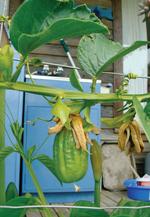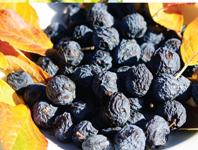Northland's Jacqui Sparrow discovers the delights of granadilla while, in the deep south, Jude Gillies is partial to prunes.
Great Granadillas
You might liken the giant granadilla to a yellow passionfruit on steroids. Its bright green leaves are huge and its edible fruit reach up
to 30cm long In ideal conditions it can grow 15 metres in a season but less in New Zealand gardens. Giant granadilla (Passiflora quadrangularis) hails from the warm tropical areas of South America, as do many of the other 400 species of passionflowers.
It is cultivated throughout Queensland and grows wild around Cairns. My friend Joy bought her baby vine from a Northland nursery and it grew quickly and steadily in her greenhouse. Before long it rampaged away and an aperture had to be cut in the roof of the greenhouse to accommodate the burgeoning plant.
 With strong, angled stems and tough tendrils, it attached itself to the neighbouring verandah and there has flourished and flowered and fruited. Joy’s plant is obviously a strain of the giant granadilla – they do hybridise recklessly. Its large, 11cm diameter, sumptuous, fragrant bloom is superb – and unforgettable with its dark blue to purple petals and sepals and its mainly white corona filaments around the typical passionflower complex of pistil, style and stigmas.
With strong, angled stems and tough tendrils, it attached itself to the neighbouring verandah and there has flourished and flowered and fruited. Joy’s plant is obviously a strain of the giant granadilla – they do hybridise recklessly. Its large, 11cm diameter, sumptuous, fragrant bloom is superb – and unforgettable with its dark blue to purple petals and sepals and its mainly white corona filaments around the typical passionflower complex of pistil, style and stigmas.
The fruit that follows forms quickly and soon grows into a titan of a passionfruit, the largest of the passionfruit genus. Melon-like in appearance, Joy’s fruit powered away and matured to a good 20cm long with a thin yellowish skin. Inside lies a layer of dense, firm creamy to lemon flesh, about 3cm thick. It has a mild pleasant flavour. The centre contains masses of pulp, sweet and honeyed, but not as intensely flavoured as our common passionfruit (P. edulis). The green fruit can be boiled and used as a vegetable.
Joy’s vine produced seven ripe fruit in summer and I was the grateful recipient of a couple. I stewed the flesh and sweetened it and cut some up for fruit salads. The pulp was delicious, as you would expect with a passionfruit, and I used it as I would any passionfruit pulp.
For success in growing this exotic plant you will need a warm, sheltered, sunny, frost-free place and a measure of good luck. Soil must be well drained as the giant granadilla, like all passionfruit, has a hearty appetite, especially for well-rotted organic matter.
Prunes Aplenty
 Rather than a time to lament the end of autumn, late May means taking stock and putting the garden to bed before winter. In southern gardens it’s also the time to make the most of the last of autumn’s seasonal bounty, which, for some lucky gardeners, may include picking prunes.
Rather than a time to lament the end of autumn, late May means taking stock and putting the garden to bed before winter. In southern gardens it’s also the time to make the most of the last of autumn’s seasonal bounty, which, for some lucky gardeners, may include picking prunes.
Although commonly grown throughout Europe, prunes are still a novelty in New Zealand but deserve to be more widely planted in the North and South Islands where European plums grow well.
In regions with cold winters and hot summers, such as Central Otago and North Canterbury and parts of the Nelson region, they make the ideal home garden tree.
Maturing at two to three metres maximum and capable of being shaped into a graceful umbrella-shaped tree, they produce typical pretty prunus blossom in spring and a bounty of sticky, sweet fruit at this time of year. As the fruit matures, in southern gardens the leaves turn a magnificent golden colour to complete its all-round appeal.
 Being a European plum, Prunus domestica flowers later than Japanese plums and avoids the spring risk of frost damage. While the fruit can be harvested when still plump and firm, in a long autumn, they can be left on the plant to develop their characteristic sticky, sweet and aromatic flavour. Like late harvested Riesling grapes, they can also be left on the plant to shrivel to the typical chewy prune texture.
Being a European plum, Prunus domestica flowers later than Japanese plums and avoids the spring risk of frost damage. While the fruit can be harvested when still plump and firm, in a long autumn, they can be left on the plant to develop their characteristic sticky, sweet and aromatic flavour. Like late harvested Riesling grapes, they can also be left on the plant to shrivel to the typical chewy prune texture.
As well as eating them raw with a blue cheese as an after-dinner delicacy, try substituting homegrown prunes for plums in a sauce recipe to take it to a whole new level.
Copyright © Weekend Gardener: www.weekendgardener.co.nz
For subscriptions and further infomation please go to the Weekend Gardener website.











Join the Discussion
Type out your comment here:
You must be logged in to post a comment.